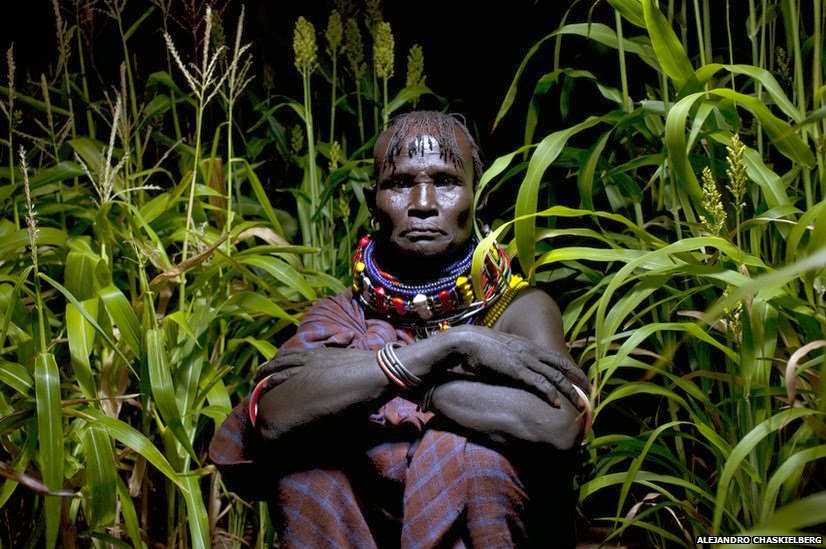Medicinal Importance of Bitter Leaf (locally called ewuro)
References for further reading
Bitter leaf is a medicinal plant of the family Asteraceae. It is a small perennial shrub that grows in tropical Africa. Vernonia amygdalina is commonly called bitter leaf because of its bitter taste and it can be propagated either by cutting or seedling. Today, the plant is widely known throughout the continent and nearly 85% of Nigerians cultivates the plant due to its nutritional and medicinal values. It is locally called 'ewuro' in yorubaland. The leaves of the plant may be consumed either as a vegetable (macerated leaves in soups) or aqueous extracts as tonics for the treatment of various illnesses.
In the wild, chimpanzees have been observed to ingest the leaves when suffering from parasitic infections. Many herbalists and naturopathic doctors recommend aqueous extracts for their patients as treatment for Emesis, nausea, diabetes, loss of appetite-induced abasia , dysentery and other gastro intestinal tract problems. Until the last decade or so, there were only anecdotal reports and claims to support the health benefits. The anecdotal reports are now being supported by scientific evidence that V.amygdalina regimen or consumption as dietary supplements may provide multiple health benefits (Ologunde et al., 1992).
V.amygdalina is a medicinal plant of Asteraceae family and has a vast importance concentrating majorly on medicinal aspect. However the plant is also useful in ecology as it helps in the beautification and purification of the environment by releasing oxygen during photosynthesis. He said V.amygdalina can also be used as food supplements when prepared with Melon (egusi soup) a nutritious African food.
An estimated 815 million people in developing countries suffer from malnutrition, and infants and children are the worst hit (FAO, 2004). Unfortunately, efforts at improving food production and accessibility in these regions have been directed lope-sidedly to roots/tubers, cereals, and animal production. The largely ignored dark green leafy vegetables can however augment the nutrients derivable from other sources, thereby reducing malnutrition tremendously. Oshodi (1992) said Leaves are easy to prepare, and contain appreciable quantities of nutrients. (Ejoh et al., 2007) reported that V. amygdalina contain significant quantities of lipids, carbohydrates, fiber and proteins with high essential amino acid score that compare favourably with values reported for Telfairia occidentalis and Talinum triangulare. The plant has also been shown to contain appreciable quantities of ascorbic acid and caroteinoids (Udensi et al.,2002). Calcium, Iron, potassium, phosphorous, manganese, copper and cobalt have also been found in significant quantities in V.amygdalina (Eleyinmi et al.,2008).
Nutrient composition of Bitter leaf which have been reported by several researchers include proteins, fibre, carbohyrate, Ascorbic acid, carotenoid, calcium, iron, phosphorus, potassium, sulphur, sodium, manganese, copper, zinc, magnesium and selenium. Active principles also reported include stigmastane-type saponins (Vernoniosides), steroidal saponins, sesquiterpene lactones (Vernolide, vernodalol, vernolepin, vernodalin, vernomygdin, hydroxyvernolide), flavonoids (luteolin), terpenese, coumarins, phenolic acids, lignans, xanthones, anthraquinones and peptides (Edoties)
Medicinal importance of bitter leaf
(Erasto et al., 2006) reported that V. amygdalina is probably the most used medicinal plant in the genus Vernonia.
V.amygdalina is a medicinal plant of Asteraceae family and has a vast importance concentrating majorly on medicinal aspect. However the plant is also useful in ecology as it helps in the beautification and purification of the environment by releasing oxygen during photosynthesis. He said V.amygdalina can also be used as food supplements when prepared with Melon (egusi soup) a nutritious African food.
An estimated 815 million people in developing countries suffer from malnutrition, and infants and children are the worst hit (FAO, 2004). Unfortunately, efforts at improving food production and accessibility in these regions have been directed lope-sidedly to roots/tubers, cereals, and animal production. The largely ignored dark green leafy vegetables can however augment the nutrients derivable from other sources, thereby reducing malnutrition tremendously. Oshodi (1992) said Leaves are easy to prepare, and contain appreciable quantities of nutrients. (Ejoh et al., 2007) reported that V. amygdalina contain significant quantities of lipids, carbohydrates, fiber and proteins with high essential amino acid score that compare favourably with values reported for Telfairia occidentalis and Talinum triangulare. The plant has also been shown to contain appreciable quantities of ascorbic acid and caroteinoids (Udensi et al.,2002). Calcium, Iron, potassium, phosphorous, manganese, copper and cobalt have also been found in significant quantities in V.amygdalina (Eleyinmi et al.,2008).
Nutrient composition of Bitter leaf which have been reported by several researchers include proteins, fibre, carbohyrate, Ascorbic acid, carotenoid, calcium, iron, phosphorus, potassium, sulphur, sodium, manganese, copper, zinc, magnesium and selenium. Active principles also reported include stigmastane-type saponins (Vernoniosides), steroidal saponins, sesquiterpene lactones (Vernolide, vernodalol, vernolepin, vernodalin, vernomygdin, hydroxyvernolide), flavonoids (luteolin), terpenese, coumarins, phenolic acids, lignans, xanthones, anthraquinones and peptides (Edoties)
Medicinal importance of bitter leaf
(Erasto et al., 2006) reported that V. amygdalina is probably the most used medicinal plant in the genus Vernonia.
- V.amygdalina extracts may help suppress, delay or kill cancerous cell in many ways, such as; Induction of apoptosis as determined in cell culture and animal studies, enhance chemotherapy sensitivity, inhibition of the growth or growth signals of cancerous cells, suppression of metastasis of cancerous cells in the body by the inhibition of an anti-apoptotic transcription factors as demonstrated in animal studies and reduction of oestrogen level in the body by the suppression of Aromatase activity.
- V.amygdalina may provide an anti-oxidant benefits. Many chronic diseases and causes of food spoilage are linked to pro-oxidants. Antioxidant principles are therefore useful in food preservation and drug formulations (Loliger, 1991).
- V.amygdalina is useful in the treatment of wounds and some gastrointestinal problems due to its anti-microbial activities.
- Many studies have shown that V.amygdalina extracts may strengthen the immune system through many cytokines (including pro inflammatory molecule) regulation.
- V.amygdalina decreased blood glucose by 50% compared to untreated animals.
- V.amygdalina being an ingredient of Cuisine. The leaf extracts reduce LDL Cholesterol by 50% while also boosting good HDL Cholesterol.
- V.amygdalina contains sesquiterpene lactone, an active ingredients used in China to produce qinghaosu a drug used for the treatment of malaria, fever and diarrhoea.
- V.amygdalina contains Myricetin an active flavonoids used in treatment of cough and as laxatives.
- Leaves decoction of V.amygdalina is used in the treatment of pneumonia and increase breast milk in nursing mother.
- V.amygdalina is used instead of hops to make beer in Nigeria.
- V.amygdalina is used as local medicine against leech and bilharziasis.
- V.amygdalina roots are useful in the treatments of tooth ache and as well prevent gum decay due to its bactericidal and anti-microbial activities.
References for further reading
- Abosi, A.O. and Raseroka, B.H (2003). “In vivo antimalarial activity of Vernonia amygdalina”. Br. J. Biomed. Sci. 60: 89-91.
- Adaramoye, O.A., Akintayo, O., Achem, J., and Fafunso, M.A (2008). “Lipid lowering effects of methanolic extracts of Vernonia amygdalina leaves in rats fed on high cholesterol diet”. Vasc. Health Risk Manage. 4: 236-241.
- Akah, P.A. and Okafor, C.L (1992). “Blood sugar lowering effect of Vernonia amygdalina in an experimental rabbit model”. Phytother. Res. 6: 171-173.
- Akinpelu, D.A (1999). “Antimicrobial activity of Vernonia amygdalina leaves”. Fitoterapia. 70: 432-434.
- Atangwho, I.J., Ebong, P.E., Eteng, M.U., Eyong, E.U., and Obi A.U (2007). “Effect of Vernonia amygdalina leaf on kidney function of diabetic rats”. Int. J. Pharmacol. 3: 143-148.
- Babalola, O.O., Anetor, J.I., and Adeniyi, F.A (2001). “Amelioration of carbon tetrachloride induced hepatotoxicity by terpenoid extract from leaves of Vernonia amygdalina”. Afr. J. Med. Sci. 30: 91-93.
- Eleyinmi, A.F., Sporns, P. and Bressler, D.C (2008). “Nutritional composition of Gongronema latifolium and Vernonia amygdalina”. Nutr. Food Sci. 38: 99-109.
- Erasto, P., Grierson, D.S., and Afolayan, A.J (2006). “Bioactive sesquiterpene lactones from the leaves of Vernonia amygdalina”. J. Ethnopharmacol.106: 117-120.
- Ezekwe, C.I. and Obidoa, O (2001). “Biochemical effect of Vernonia amygdalina on rats liver microsomes”. Nig. J. Biochem. Mol. Biol. 16: 174S-179S.
- Farombi, E.O (2003). “African indigenous plants with chemotherapeutic potentials and biotechnological approach to the production of bioactive prophylactic agents”. Afr. J. Biotech. 2: 662-667
Labels: Biological Science


No comments:
Post a Comment